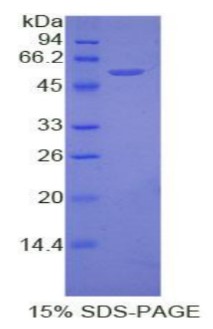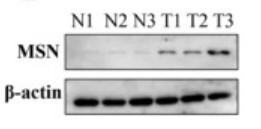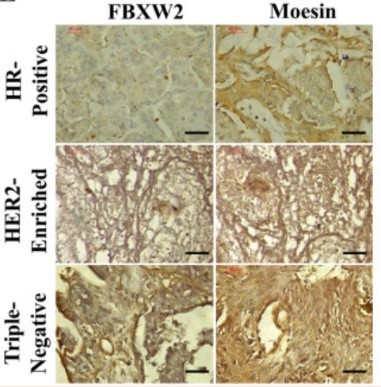MSN
-
Official Full Name
moesin
-
Overview
Moesin (for membrane-organizing extension spike protein) is a member of the ERM family which includes ezrin and radixin. ERM proteins appear to function as cross-linkers between plasma membranes and actin-based cytoskeletons. Moesin is localized to filopodia and other membranous protrusions that are important for cell-cell recognition and signaling and for cell movement. -
Synonyms
MSN; moesin; membrane-organizing extension spike protein;
- Recombinant Proteins
- Cell & Tissue Lysates
- Protein Pre-coupled Magnetic Beads
- Chicken
- Human
- Mouse
- Rat
- Rhesus Macaque
- E.coli
- HEK293
- HEK293T
- In Vitro Cell Free System
- Mammalian Cell
- Mammalian cells
- Sf9 Insect Cell
- Wheat Germ
- DDK
- Flag
- GST
- His
- His (Fc)
- Avi
- His|GST
- His|T7
- Myc
- N/A
- N
- Background
- Quality Guarantee
- Case Study
- Involved Pathway
- Protein Function
- Interacting Protein
- MSN Related Articles
What is MSN protein?
MSN (moesin) gene is a protein coding gene which situated on the long arm of chromosome X at locus Xq12. The protein encoded by this gene is called Moesin (also known as MSN). MSN is a membrane tissue extension spike protein that is a member of the ERM (Ezrin-Radixin-Moesin) family, consisted of 577 amino acids and is approximately 67.8 kDa.
What is the Function of MSN protein?
MSN modulates epithelial integrity by regulating cell-signalling events that affect actin organization and polarity. The effects of MSN on epithelial cells appear to result from inhibition of Rho signaling. ERM proteins serve a structural role in linkage of the cytoskeletion to the plasma membrane and the rescue of cells lacking MSN by modulation of Rho signaling indicates that inhibition of Rho activity may be a more critical function of MSN. The role of MSN is particularly important in immunity acting on both T and B-cells homeostasis and self-tolerance, regulating lymphocyte egress from lymphoid organs and it participates also in immunologic synapse formation.
MSN Related Signaling Pathway
The mitogen-activated protein kinase (MAPK) signaling pathway is one of the major signaling pathways associated with MSN. This pathway consists of a cascade of protein kinases that transmit signals from the cell surface to the nucleus, resulting in the regulation of various cellular processes such as cell growth, differentiation, and survival. Additionally, the MAPK signaling pathway can also crosstalk with other signaling pathways, such as the PI3K-Akt pathway, to regulate cell survival and apoptosis.
MSN Related Diseases
Neurological disorders: MSN has been implicated in the pathogenesis of neurodegenerative disorders, such as Alzheimer's disease and Parkinson's disease. Cancer: Abnormal expression or activation of MSN has been observed in several types of cancer, including breast cancer, colorectal cancer, pancreatic cancer, and lung cancer. Autoimmune diseases: MSN has been linked to several autoimmune diseases, such as Immunodeficiency 50 (IMD50), systemic lupus erythematosus (SLE), measles and rheumatoid arthritis. Also, MSN protein plays an important role in inflammatory response, which may be related to the occurrence and development of diseases such as rheumatoid arthritis and inflammatory bowel disease.

Fig1. The expression level of protein and mRNA about moesin in eight LAC patients with the carcinoma and the adjacent normal tissues.
Bioapplications of MSN
MSN protein has a promising application in the fields of drug delivery of mesoporous silica nanoparticles, photodynamic therapy, biosensor and tissue engineering. Understanding the role of MSN in these processes can also have implications in cancer metastasis and wound healing.
High Purity

Fig1. SDS-PAGE (MSN-7974H) (PROTOCOL for western blot)
.

Fig2. SDS-PAGE (MSN-317H)
Case Study 1: Jing Zhuang, 2023

Fig1. The expression of MSN was significantly promoted in lung cancer patients, and MSN is a potential marker of lung cancer.
Case Study 2: Ganesh Kumar Barik, 2023

Fig2. Representative immunohistochemistry (IHC) images showing FBXW2 and Moesin staining of tissue sections of three subtypes of breast cancer patients.
MSN involved in several pathways and played different roles in them. We selected most pathways MSN participated on our site, such as Leukocyte transendothelial migration, Regulation of actin cytoskeleton, Measles, which may be useful for your reference. Also, other proteins which involved in the same pathway with MSN were listed below. Creative BioMart supplied nearly all the proteins listed, you can search them on our site.
| Pathway Name | Pathway Related Protein |
|---|---|
| Leukocyte transendothelial migration | BCAR1;CLDN8;GNAI1;NOX1;PIK3R3;CLDN9;PIK3CG;CD99;GNAI3 |
| Regulation of actin cytoskeleton | PPP1R12C;F2;VIL1;PIP4K2AA;RHOA;SSH3;PPP1CC;DIAPH3;INS2 |
| Measles | Il2;IFIH1;PIK3CD;TNFSF10;IFNA12;IL1A;IFNA10;TNFAIP3;IL1B |
| Proteoglycans in cancer | MET;PTPN11;PIK3CB;VEGFA;KRAS;WNT3;CD44;EZR;CBLC |
MSN has several biochemical functions, for example, actin binding, cell adhesion molecule binding, double-stranded RNA binding. Some of the functions are cooperated with other proteins, some of the functions could acted by MSN itself. We selected most functions MSN had, and list some proteins which have the same functions with MSN. You can find most of the proteins on our site.
| Function | Related Protein |
|---|---|
| actin binding | CALD1B;SMTN;DBNL;MYPN;MICAL1;SNTA1;VPS16;DAG1;TWF2B |
| cell adhesion molecule binding | Fert2;ITGB3;AMICA1;ITGA4;FGFR1;TIGIT;CAML;CD1d1;LILRB2 |
| double-stranded RNA binding | AGO1;PRKRIP1;APTX;HMGB1;SUPV3L1;EIF4A1;LRRFIP1;DHX15;TUBB4B |
| protein binding | OLA1;KCTD14;ZNF114;GSTO1;PFDN4;FAM40A;EHD1;POU3F2;FAM127B |
| protein kinase binding | HNRNPA0;TICAM1;CACNB2;TRIM22;CAMK2N1;MSN;GCSAM;TRPV4;ATG13 |
| receptor binding | GRP;HFE2;NPY;RIPK2;MAP7;TYROBP;PVRL3B;NRG1;HSPA1B |
| structural constituent of cytoskeleton | TUBB2;TUBA8L4;BKJ;EPB41;CYLC1;EPB41L3;ACTL7A;DMD;TUBA4A |
MSN has direct interactions with proteins and molecules. Those interactions were detected by several methods such as yeast two hybrid, co-IP, pull-down and so on. We selected proteins and molecules interacted with MSN here. Most of them are supplied by our site. Hope this information will be useful for your research of MSN.
LRRK2; SLC9A3R1
- Q&As
- Reviews
Q&As (5)
Ask a questionSeveral therapeutic strategies are being explored to modulate MSN protein expression, including small molecule inhibitors and gene silencing techniques.
Research suggests that MSN protein levels can serve as a potential biomarker for cancer detection, offering a non-invasive method for early diagnosis.
Yes, there are ongoing clinical trials investigating the efficacy of drugs targeting MSN protein in cancer treatment.
MSN protein's role in cell structure and signaling makes it a potential candidate for applications in regenerative medicine, particularly in tissue engineering.
MSN protein plays a crucial role in promoting cell migration and invasion by facilitating the rearrangement of the actin cytoskeleton and promoting cellular motility.
Customer Reviews (3)
Write a reviewIts ease of use and versatility make it an excellent choice for various applications, including ELISA assays and protein electron microscopy structure analysis.
I have consistently obtained outstanding results using the MSN Protein, which has significantly enhanced the efficiency and reliability of my research.
Its exceptional performance and reliable outcomes make it an invaluable asset in advancing scientific understanding and uncovering important biological insights.
Ask a Question for All MSN Products
Required fields are marked with *
My Review for All MSN Products
Required fields are marked with *


